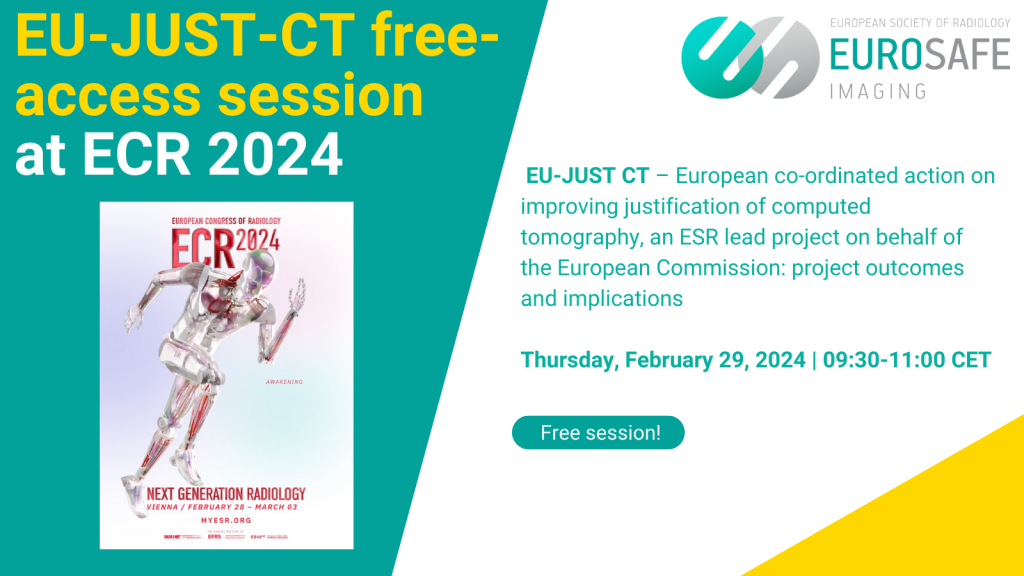About
Latest updates
EU-JUST-CT free-access session at ECR 2024

The recording of the session is available at ESR Connect FOR FREE!
Instructions on how to join can be found here.
Workshop proceedings available now
On 28-29 September, the EU-JUST-CT project held an important hybrid workshop to discuss how to improve the justification of computed tomography in the EU. The central aim of the workshop was to share the results of the audits of CT justification in seven European countries. Read more in the workshop proceedings here.
Audit Methodology
The common methodology for auditing justification of CT examinations that has been developed as part of the project is freely available here.
About the EU-JUST-CT project
The EU-JUST-CT project is funded by the European Commission’s Directorate General for Energy (N° ENER/D3/2020-74). Ionising radiation is widely used for medical diagnosis and treatment of major diseases, such as cancer and cardiac conditions. With about five-hundred million procedures carried out in the EU annually, diagnostic uses of ionising radiation – including x-ray based plain and computed tomography (CT) radiology, diagnostic nuclear medicine and hybrid imaging – are by far the most common.
While indispensable for modern medicine, ionising radiation is also a known carcinogen. European legislation (Council Directive 2013/59/Euratom (BSS)) has been issued, aiming to ensure that the medical uses of ionising radiation are appropriately justified and the radiation protection of patients and medical staff is optimised in line with international principles and guidance.
The BSS requires medical exposures to be ‘justified’, to ensure that their health benefit outweighs the individual detriment that the exposure might cause, taking into account the efficacy, benefits and risks of available alternative techniques. The Directive further requires individual radiological procedures to be justified in advance taking into account the specific objectives of the procedure and the patient’s characteristics, and prescribes a justification process under the clinical responsibility of a radiological practitioner and involving the referring physician. The Directive also requests Member States to introduce referral guidelines for medical imaging, which should be made available to the referrers.
In the past couple of decades, the rise of computed tomography (CT) has led to significant increase in the patient radiation doses in advanced economies. CT is now responsible for more than half of the medical radiation exposure of the EU citizens, and is a subject of particular concern. Several studies have shown a significant rate of unjustified computed-tomography (CT) exams, in the range of 20-40% overall and reaching more than 70% for some procedures.
Recognising the significance of this, in December 2015 the Council issued Conclusions on “Justification of medical imaging involving exposure to ionising radiation”. The Council Conclusions call upon Member States to undertake actions to improve the situation, including strengthening the application of clinical audits in relation to justification and the implementation of referral guidelines for medical imaging.
Notwithstanding the above studies and initiatives, only a limited number of national audits and studies of CT justification have been carried out in Member States. The general objective of the EU-JUST-CT project is to improve the justification of computed tomography in the EU through the development and implementation of common approach and co-ordinated action in this area among Member States. The work is part of the broader SAMIRA initiative and closely related to the Commission’s ongoing work on clinical audit e.g. the QuADRANT project.
As part of a series on Quality & Safety, an Open Access Session to promote and discuss the EU-JUST-CT project’s work to date was held on 1st March 2023 at the ECR 2023.
A Workshop was held on 28th – 29th September in Luxembourg and remotely to present the results of the audits of CT justification in seven Member States and to discuss a European guidance document to improve justification of CT examinations (see here). For more information, please click here.